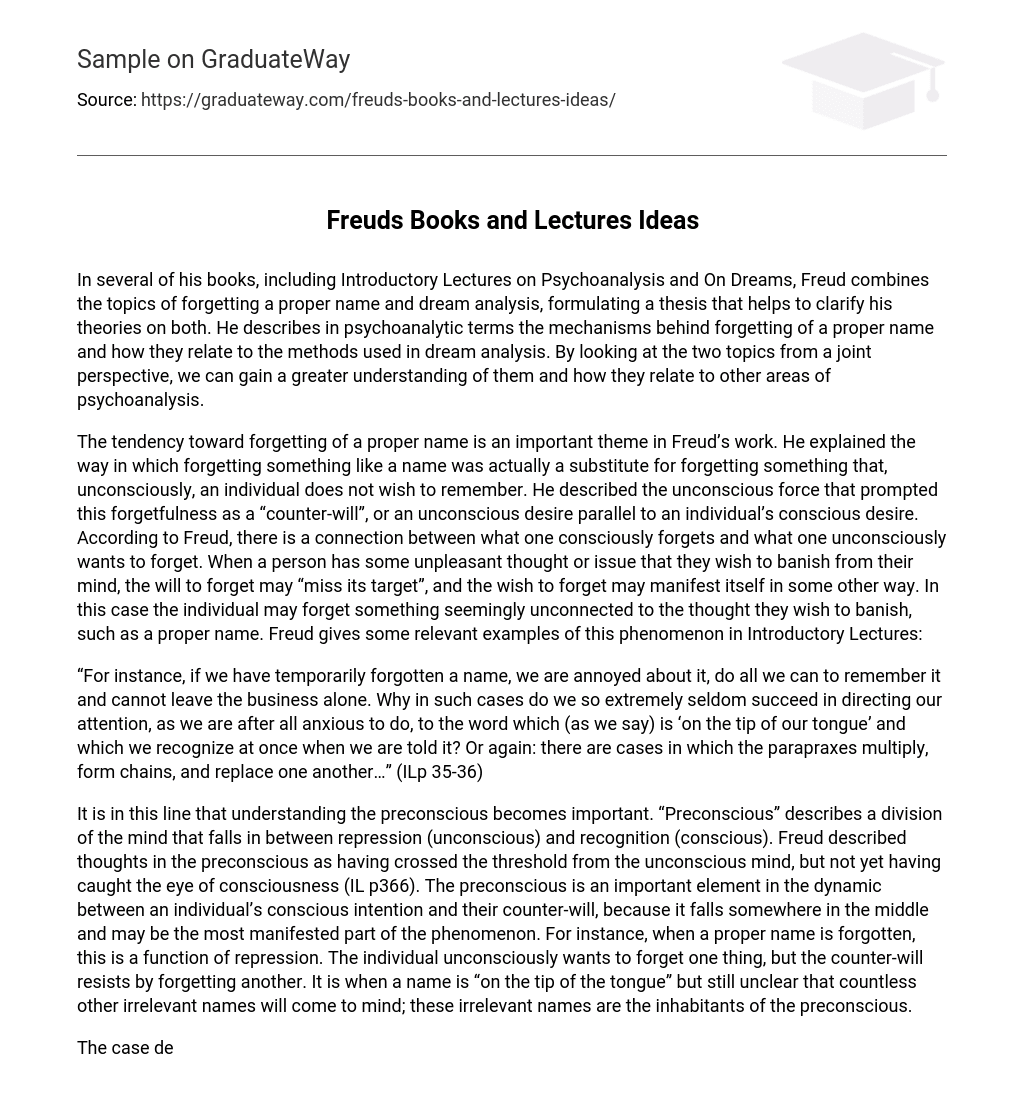Freud explores the concepts of forgetting a proper name and dream analysis in multiple books, like Introductory Lectures on Psychoanalysis and On Dreams. Through this exploration, he develops a thesis that sheds light on his theories regarding both topics. Freud applies psychoanalytic principles to explain the mechanisms behind forgetting a proper name and their connection to dream analysis methods. By examining these subjects together, we can enhance our comprehension of these ideas and their interplay with other aspects of psychoanalysis.
Freud’s work explores the tendency to forget proper names and how it relates to unconscious desires. He theorized that forgetting a name is actually a way of forgetting something that an individual unconsciously does not want to remember. This forgetting is driven by a counter-will, an unconscious desire that parallels conscious desires. Freud posited a connection between conscious forgetting and unconscious desires. When there is an unpleasant thought or issue that someone wants to repress, the will to forget may miss its intended target and manifest itself in unrelated ways, such as forgetting a name. In his Introductory Lectures, Freud provides relevant examples of this phenomenon.
“In instances where we have temporarily forgotten a name, we feel frustrated and make considerable effort to recall it but are unable to focus our attention solely on the word that we know is ‘on the tip of our tongue’ and instantly recognize once it is told to us. Similarly, there are scenarios where parapraxes occur repeatedly, forming chains and replacing each other…” (ILp 35-36)
Understanding the preconscious is crucial in this context. The term “preconscious” refers to a part of the mind that is between the unconscious (repression) and the conscious (recognition). According to Freud, thoughts in the preconscious have moved from the unconscious mind but have not yet entered consciousness (IL p366). The preconscious plays a significant role in the interplay between an individual’s conscious intention and their counter-will, as it lies in the middle and may be the most evident aspect of this phenomenon. For example, when someone forgets a proper name, it is a result of repression. The individual unconsciously wants to forget one thing, but their counter-will opposes by causing them to forget another. When a name is almost remembered but still unclear, numerous irrelevant names from the preconscious come to mind.
The Psychopathology of Everyday Life features a case in which Freud recounts his personal encounter with forgetting a proper name. This case serves as an insightful illustration of the underlying mechanism behind this phenomenon, as Freud not only describes the situation but also extensively examines its significance.
In 1898, when I attempted to remember the name of the artist who created the breathtaking frescoes of the ‘Four Last Things’ in Orvieto Cathedral, I was unsuccessful. Instead of the name I desired, Signorelli, the names of two other painters, Botticelli and Boltrafio, came to mind. However, I quickly dismissed these names as incorrect. Interestingly, when someone else informed me of the correct name, I immediately recognized it without any doubt or hesitation (PEL p2).
The act of remembering a forgotten name and subsequently bringing it back to consciousness leads to a complex analysis of the reasons behind the substitutions that occurred. Freud’s inclusion of a chart in Psychopathology of Everyday Life attempts to explain these substitutions, but I personally find it unconvincing. However, the chart does help Freud trace the substituted name back to the repressed material. Whether the chart and its analysis are unnecessary to this discovery is still uncertain to me. Freud’s method of using the initial letters of mixed up words to connect them and establish coherence seems too systematic and simplified to be attributed solely to the unconscious mind. Nevertheless, it does seem to validate his arguments on the issue.
Comparing the act of forgetting names with dream analysis adds depth to our understanding of both phenomena. While both focus on the unconscious mind, there is a distinction between the roles of the unconscious and preconscious in these instances. Dream analysis involves uncovering unconscious thoughts that are waiting to be revealed during sleep. These thoughts may not be recognized in any other form except through dreams, as they may be repressed or have not yet reached the conscious level. On the other hand, forgetting a name feels like the answer is just out of reach in the conscious mind. In this case, both the forgotten material and the substituted memory are located in the preconscious mind, which is between conscious and unconscious thought.
The connection between these two areas of thinking can be seen in hypnosis. In a hypnotic state brought on by suggestion, a person can access both preconscious and unconscious thoughts and express them while still awake. This is beneficial for both the psychoanalyst and the patient. During hypnosis, the patient can reach unconscious information that would otherwise be hard to uncover and interpret.
Understanding the concepts of forgetting a proper name and the dream work is crucial in comprehending Freud’s work. Comparing and contrasting these areas allows for valuable insights into both. Freud’s work has had a significant impact on American society, both culturally and clinically, making it highly relevant to study in the present day.





